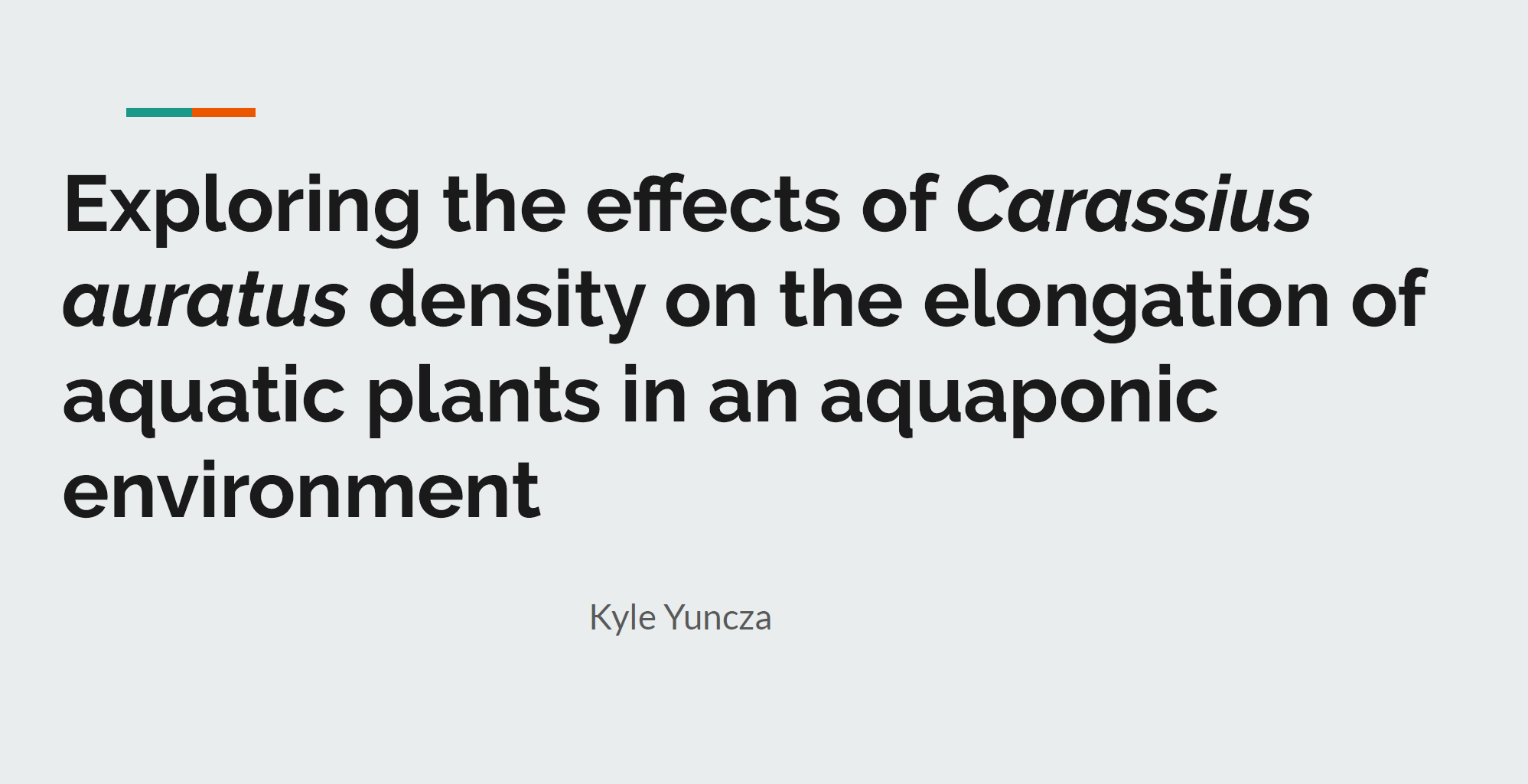Exploring the effects of Carassius auratus density on the elongation of aquatic plants in an aquaponic environment
Event: Senior Division
Category: Animal Science
Student: Kyle Yuncza
Table: ANIM1000T
Experimentation location:
Regulated Research (Form 1c): No
Project continuation (Form 7): No
Abstract:
Stress is a sensation that is usually experienced by every organism. Stress affects many functions in an organism such as cognitive function, behaviour, and various metabolic processes. A notable result of psychological stress is bowel dysfunction. The relationship between stress and the gastrointestinal tract has long since been explored by researchers (Chang, 2014) in rats, where stress has disrupted intestinal barrier integrity. The stress-induced corticotropin-releasing factor (CRF) pathway reacts to an increase in stress hormone by negatively affecting gastrointestinal motility.Using this information, this experiment examined the relationship between stress in Carassius auratus and the effect of bowel dysfunction on the growth of aquatic plants. Fish were grouped in tanks with various numbers including tanks with 4 fish, 2 fish, and a singular fish. The ideal amount of fish, 2, acted as the control, simulating a fish and its mate, with adequate room for the fish to swim freely. The other two tanks simulated the effects of isolation and overcrowding in an aquatic environment. It was predicted that the tank with 4 fish would experience the most plant growth, due to the heightened amount of stress experienced by the overcrowding of the tank and limited resource availability .
In a two week time span, the results of the experiment show that the growth of the plant in the tank with the isolated fish had optimal growth at 15% followed by a 6% growth in the overcrowded tank and 1% growth in the control tank. This refuted our hypothesis that fish suffer the most amount of stress in an overcrowded environment, revealing that isolation exerts more stress on Carassius auratus. This is exemplified by the optimal growth of the aquatic plant in the isolation tank, which grew nearly double that of the overcrowded tank.
Bibliography/Citations:
Abstract Chang, Y. M., El-Zaatari, M., & Kao, J. Y. (2014). Does stress induce bowel dysfunction?. Expert review of gastroenterology & hepatology, 8(6), 583–585. https://doi.org/10.1586/17474124.2014.911659
Additional Project Information
Project website: -- No project website --
Presentation files: -- No files provided --
Research paper:
Additional Resources: -- No resources provided --
Project files: -- No files provided --
Research Plan:
Materials:
- 3 fish tanks( 3 Gallons)
- 7 goldfish
- Water Quality test strips(pH, CaCo3)
- 3 aquatic plants
- Ruler
- Fish food flakes
Procedure:
- 7 goldfish would be obtained along with 3 aquatic plants
- The fish will be allowed a month acclimation period, without the plants.
- 3 separate, but identical fish tanks would be used to house the fish
- One tank would have 1 goldfish - Isolated tank -
- Another tank would have 2 goldfish - ideal tank -
- The final tank would have 4 goldfish - overcrowded tank -
- Every other day, the pH, plant growth and a video of the fishes behavior will be recorded
- -This would go on for about ~2 months and by the end the differences between the tanks should be recorded.
- -All fish tanks will receive the same amount of fish food, that which being the amount the ideal tank is getting. This is to be able to simulate resource scarcity and abundance. Ideally this would happen at the same time every day.
Safety precautions:
- The fish will be kept away from harmful chemical or materials otherwise present in the lab.
- The fish will be kept away from students in order to protect the isolation aspect of the experiment and for the fishes own safety.
- The fish will be provided enough food to stay alive, and the tank will be cleaned of algae and other waste if present in excessive amount to the determent of the fish’s health. All tanks will be cleaned out if even one is too dirty.

